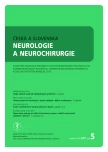Tissue Oxygen Measurement in the Brain as a Part of Multimodal Monitoring: Case Reports
Authors:
R. Gál 1; M. Smrčka 2; P. Štourač 1; E. Straževská 1; E. Neumann 2
Authors‘ workplace:
Anesteziologicko-resuscitační oddělení FN Brno
1; Neurochirurgická klinika LF MU a FN Brno
2
Published in:
Cesk Slov Neurol N 2007; 70/103(5): 562-566
Category:
Case Report
Práce podporována grantem IGA MZ ČR č. 8837-3.
Overview
Multimodal monitoring is of vital importance in neurointensive care. In recent years, multimodal monitoring has gradually incorporated also the measurement of tissue oxygen in the brain tissue (PbrO2). Measurement of (PbrO2) provides continuous quantitative data which contributes to the correct management of treatment and important prognostic and pathophysiological data for the detection of secondary brain injuries. Even though the PbrO2 value for hypoxia has not yet been unequivocally determined, there is apparently a direct link between low values of PbrO2 and higher morbidity and mortality. The article describes two cases of patients with severe craniocerebral injury and subarachnoidal bleeding where measurement of PbrO2 was applied. In the first patient, over-threshold values of PbrO2 were obtained after two hours of targeted treatment. In the second patient, the value of PbrO2 was higher than 15 mmHg for the whole period of measurement.
Key words:
brain tissue oxygenation – multimodal monitoring – craniocerebral injury – subarachnoidal bleeding
Sources
. Meixenberger J, Renner C, Simanowski R, Schmidke A, Dings J, Roosen K. Influence of cerebral oxygenation following severe head injury on neuropsychycal testing. Neurol Res 2004; 26 : 414-417.
2. Coles JP, Fryer TD, Smielewski P, Chatfield DA, Steiner LA, Johnston AJ et al. Incidence and mechanism of cerebral ischemia in early clinical head injury. J Cereb Blood Flow Metab 2004; 24 : 202-211.
3. Gracias VH, Guillamondegui OD, Stiefel MF, Wilensky EM, Bloom S, Gupta R et al. Cerbral cortical oxygenation: a pilot study. J Trauma 2004; 56 : 469-472.
4. Reinhart M, Barth A, Rothen HU, Schaller B, Takala J, Seiler RW. Effects of cerebral perfusion pressure and increased fraction of inspired oxygen on brain tissue oxygen, lactate, and glucose in patients with severe head injury. Acta Neurochir (Wien) 2003; 145 : 341-349.
5. Rose JC, Neill TA, Hemphill JC 3rd. Continuous monitoring of the microcirculation in neurocritical care: an update on brain tissue oxygenation. Curr Opin Crit Care 2006; 12(2): 97-102.
6. Timofeev I, Gupta A. Monitoring of head injured patients. Curr Opin Anesthesiol 2005; 18(5): 477-|483.
7. Hoelper BM, Allesandri B, Heimann A, Behr R, Kempski O. Brain oxygen monitoring: in vitro accuracy, long-term drift and response-time of Licox a nd Neurotrend sensors. Acta Neurochir (Wien) 2005; 147 : 767-774.
8. Longhi L, Stoccheti N. Hyperoxia in head injury: therapeutic tool? Curr Opin Crit Care 2004; 10 : 105-109.
9. Jaeger M, Soehle M, Schuhmann MU, Winkler D, Meixenberger J. Correlation of continuously monitored regional cerebral blood flow and brain tissue oxygen. Acta Neurochir (Wien) 2005; 147 : 51-56.
10. Johnson AJ, Steiner LA, Chatfield DA, Coles JP, Hutchinson PJ, Al-Rawi PG et al. Effect of cerebral perfusion pressure augmentation with dopamine and norepinephrine on global and focal brain oxygenation after traumatic brain injury. Intensive Care Med 2004; 30 : 791-797.
11. Zhi D, Zhang S, Lin X. Study on therapeutic mechanism and clinical effect of mild hypothermia in patients with severe head injury. Surg Neurol 2003; 59 : 381-385.
12. Stiefel MF, Heuer GG, Smith MJ, Bloom S, Maloney-Wilensky E, Gracias VH et al. Cerebral oxygenation following decompressive hemicraniectomy for the treatment of refractory intracranial hypertension. J Neurosurg 2004; 101 : 241-247.
13. Stiefel MF, Spiotta A, Gracias VH, Garuffe AM, Guillamondegui O, Maloney-Wilensky E et al. Reduced mortality rate in patients with severe traumatic brain injury treated with brain tissue oxygen monitoring. J Neurosurg 2005; 103 : 805-811.
14. Valadka AB, Gopinath SP, Contant CF, Uzura M., Robertson CS. Relationship of brain tissue PO2 to outcome after severe head injury. Crit Care Med 1998; 26 : 1576-1581.
Labels
Paediatric neurology Neurosurgery NeurologyArticle was published in
Czech and Slovak Neurology and Neurosurgery

2007 Issue 5
Most read in this issue
- Treatment of Epileptic Syndromes in Children
- Assesment of Optic Disc Edema
- Are some of the contraindications for lumbar punction outdated today? A Case Report
- Transforaminal lumbar interbody fusion (TLIF) and instruments. Prospective study with the minimum of 20-month follow-up
